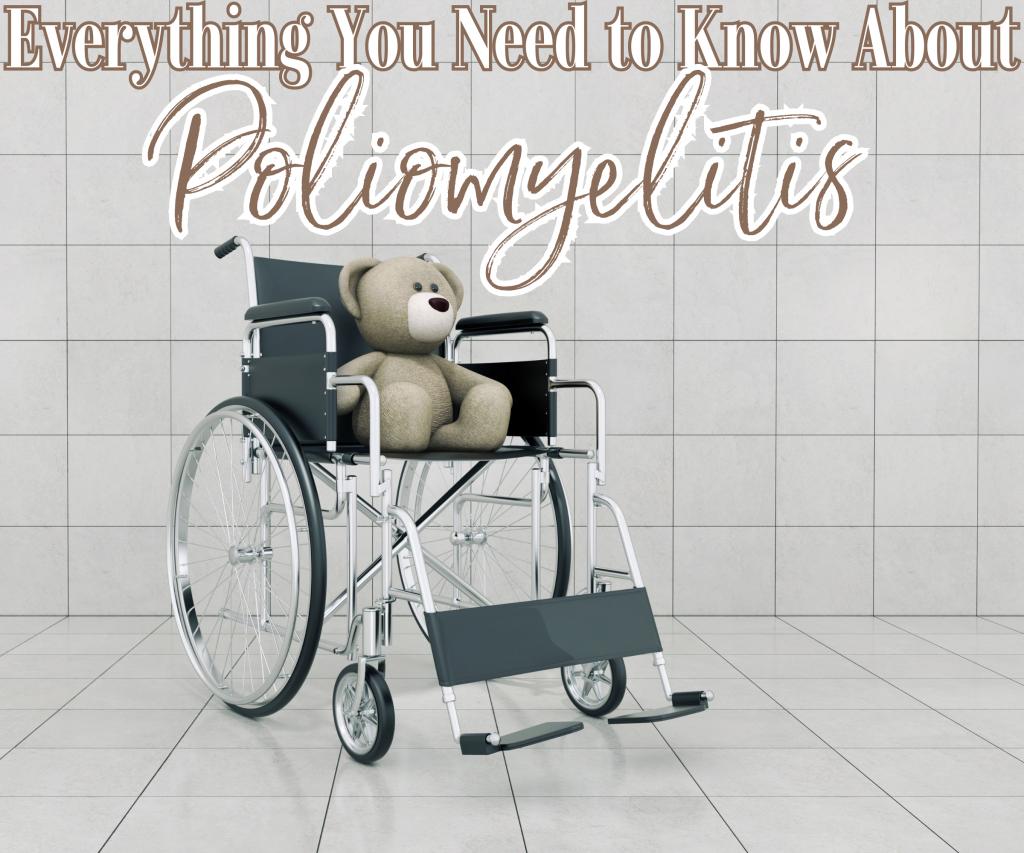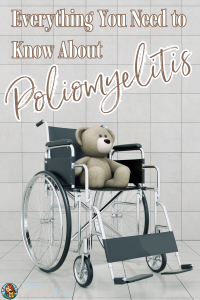Polio. One of the most feared illnesses worldwide. Many people hear stories of paralysis and iron lungs and become emotional. They think about Franklin D Roosevelt, diagnosed with paralysis in 1912, which was assumed to be polio. Some people argue that FDR swam in a contaminated body of water the day before his onset of symptoms, which resulted in his paralysis. Although sources support the swimming claim, we cannot confirm if it was contaminated (1). But what if it runs deeper than that, like a misdiagnosis?
Interestingly, sources claim FDR was misdiagnosed twice before his polio diagnosis (1), so a third time wouldn’t be too surprising. Additionally, recent studies suggest FDR’s age and many illness features are more consistent with a diagnosis of Guillain-Barré syndrome, not polio (2). But that’s just the start, and we will talk more about polio being misdiagnosed later.
As someone with an online following surrounding vaccine education, polio is the number one reason most people think vaccines are necessary and should be mandatory. Daily, I am told that my content is scaring people away from vaccines, and I am trying to bring back polio. Thankfully that’s not the case, and the vaccine corruption runs deeper than most think, but it started with the polio vaccine.
This blog is dedicated to exposing corruption and inconsistencies to allow you (the reader) to know all the information. This isn’t a conspiracy theory and is brimming with reputable sources, even mainstream sources contradicting themselves every step of the way. I hope the information encourages you to make an informed decision based on all facts, not just the mainstream media’s scare tactics.
Everything You Need to Know About Poliomyelitis
The first known clinical description of suspected poliomyelitis (polio) was in 1789 by British doctor Michael Underwood (3). Polio didn’t have a name until 1840 when it was named Heine-Medin disease after contributing physicians Jakob Heine and Karl Oskar Medin (4). When Heine-Medin disease was renamed to polio is unclear.
Poliomyelitis, or polio, is an infectious disease transmitted by fecal-oral contamination with lymphatic replication (5). Poliomyelitis describes the syndrome of acute flaccid limb weakness and lesions in the grey matter of the spinal cord (6). Most people who get poliovirus have no visible symptoms. Roughly 25% of poliovirus infections include two to five days of flu-like symptoms like a sore throat, fever, tiredness, nausea, headache, and stomach pain that go away on their own.
For some people, poliovirus can infect the spinal cord or brain; this may lead to meningitis or paralysis. Supposedly, even after fully recovering, people can develop post-polio syndrome 15 to 40 years later, classified as muscle pain, weakness, or paralysis (7). Ironically, when someone doesn’t react to a vaccine immediately, correlation doesn’t equal causation, but 15 to 40 years after polio, we claim it’s post-polio syndrome.
Although polio had existed for centuries, the polio panic didn’t start until the late 19th and early 20th centuries. Epidemics like the 1916 and 1952 outbreaks reportedly killed just over 5,000 people contributing to the widespread fear and the urge for a vaccine solution (3). Bringing us to the invention and an unmentioned history of the polio vaccine.
Many people believe polio has been renamed. Although mainstream fact-checkers claim polio has never been renamed, we know this is untrue since polio was originally called Heine-Medin disease. John Hopkin’s Medicine notes three polio-like viruses that can be misdiagnosed – acute flaccid myelitis, transverse myelitis, and Guillain-Barre syndrome (8). We don’t have adenovirus-like or hepatitis-like viruses, but we have polio-like viruses?
History of the Polio Vaccine
In 1954, Dr. Jonas Edward Salk created the first American polio vaccine. The following year after trials, Dr. Thomas Francis, Jr., UM Director of the Poliomyelitis Vaccine Evaluation Center, claimed the vaccine was safe and 80 to 90 percent effective at preventing paralytic polio. The vaccine was licensed for public use on the same day, and a mass polio vaccination program was set up.
During the first mass polio vaccination program, 1.6 million Americans received vaccines. What they don’t tell you is that the program was discontinued within a month after failing to deactivate the live virus. The mistakes of these medical experts resulted in a documented 40,000 cases of polio, 200 cases of paralysis, and 10 fatalities (9). The polio vaccine was licensed in 1962 with no corresponding documents until an FDA-approved inactivated polio vaccine in the 2000s (10,11). Mind you, there’s no evidence backing the original safety and efficacy claim.
The number of polio, paralysis, and death cases may be more if you want to consider the chances of post-polio syndrome onsetting 15 to 40 years after polio the 1955 vaccination exposure. Post-polio syndrome aligns with the timeline, considering that it would have occurred in between 1970 and 1995 when the polio panic peaked.
Unfortunately, the mainstream media and doctors have always loved scare tactics. If they can scare you into thinking your child or yourself will die if they contract an illness, you’re more likely to do whatever you can to prevent it, and they thought of this back in 1955; they knew the risks of the original polio vaccine were high. In a study called “A calculated risk”: the Salk polio vaccine field trials of 1995, they stated:
“Someone asked whether the placebo control plan would make it more difficult to obtain the parents’ consent. The group decided that it could rely on the widespread fear of the disease; members agreed that “it would not be difficult to sell as there is a high attack rate in the three grades [and] there would still be a 50% chance of a child receiving the vaccine (12).”
Today, most polio cases are not wild poliovirus but vaccine-induced polio. For instance, one study mentions the last defined case of natural polio in the United Kingdom was in 1984. Between 1985 and 2002, 75 percent of reported paralytic polio cases were vaccine-induced (13). Additionally, in 2022, the United States had a case of vaccine-induced polio, which impacted an unvaccinated individual (14).
Many believe the vaccines are responsible for eradicating (or decreasing polio cases today). Unfortunately, many do not realize that originally there were no set diagnostic criteria for polio. In 1960 a panel discussion noted, “Differences in diagnostic criteria for non-paralytic and paralytic cases introduced as a result of the 1954 killed polio-vaccine trial are thought to be the major cause of the fall in the incidence of reported poliomyelitis m 1957 (15).”
The World Health Organization claims herd immunity for polio could be achieved at an 80% threshold, which has been achieved (16,17). Ironically, they also claim, “As long as a single child remains infected, children in all countries are at risk of contracting polio (18).”
Furthermore, as mentioned earlier, polio is transmitted by fecal-oral contamination. Studies have found that handwashing removed poliovirus from the skin (19). In other words, incorporating basic handwashing is responsible for eradicating wild polio (20). Contrarily, vaccines inducing polio are likely why we don’t live in a polio-free world today.
Ingredients in the Polio Vaccine
When was the last time a doctor gave you an actual vaccine insert? I’m not talking about the single print-out sheet they give you in the doctor’s office, but the one that tells you all the ingredients, adverse reactions, and how to report an adverse event.
There are two polio vaccines. In America, we have the inactivated polio vaccine (IPV), and in other countries, they have the oral polio vaccine (OPV) (21). Both vaccines seem to have collaborations with the Bill and Melinda Gates Foundation and alarmingly high adverse event rates (22).
According to the CDC’s Epidemiology and Prevention of Vaccine-Preventable Diseases: The Pink Book, Appendix B, under the vaccine excipient table, the inactivated polio vaccine contains: calf bovine serum albumin, 2-phenoxyethanol, formaldehyde, neomycin, streptomycin, polymyxin B, and M-199 medium (23).
Calf Bovine Serum Albumin
There are several variations of bovine serum albumin in various vaccines, including bovine serum albumin, bovine albumin, fetal bovine serum, bovine calf serum, calf bovine serum albumin, and more. In the polio vaccine, we have calf bovine serum albumin.
Bovine serum albumin, also known as BSA or Fraction “V,” is a serum albumin protein isolated from cows. According to the material safety data sheet, albumin from bovine serum may be harmful if inhaled, swallowed, or absorbed through the skin. It may also cause respiratory tract, skin, and eye irritation. Additionally, no data is available on this ingredient’s toxicological effects (24).
BSA has reportedly caused membranous nephropathy in early childhood, and the risk of transmitting a new variant of Creutzfeldt-Jakob disease (nvCJD) by recombinant proteins is unknown (25). Additionally, a study notes although the most‐used protocol for fetal bovine serum (FBS) extracellular vesicle (EV) depletion has been optimized over the years, it does not eliminate exogenous EVs and macromolecules, resulting in side effects (26).
2-Phenoxyethanol
2-phenoxyethanol is an aromatic ether that is phenol substituted on oxygen by a 2-hydroxyethyl group and is typically used as a preservative or stabilizer (27). Exposure to phenoxyethanol has been linked to things as minor as eczema to severe, life-threatening allergic reactions (28,29). Oral exposure in infants can impair nervous system function (30). Additionally, In 2008, the FDA recalled it as unsafe for breastfeeding infants due to concerns about how it affects their central nervous system (31).
Even the mainstream recognizes these concerns. One mainstream source states phenoxyethanol is unsafe for infants (32). Another mainstream source says to avoid phenoxyethanol if you’re pregnant, breastfeeding, or considering using it on a child under 3 years old (33). So if they’re aware it is unsafe, why do they recommend three doses of the polio vaccine by 18 months of age (34)?
Formaldehyde
If you read our blog, Everything You Need to Know About Formaldehyde, you know there is naturally occurring and synthetically made formaldehyde. The formaldehyde used in vaccines is synthetically made by combining methyl alcohol vapors, and the air is passed over a platinized asbestos, copper, or silver catalyst (35). Additionally, we discussed the many risks associated with formaldehyde, so I’ll keep it short here.
According to the Minnesota Department of Health, short-term exposure to formaldehyde can cause coughing, headaches, dizziness, nausea, and eye, nose, and throat irritation (36), but that’s just the start. Based on toxicological data and epidemiological evidence obtained in workplaces, formaldehyde has been a categorized group 1 carcinogen for humans since 2004 (37). A categorized group 1 carcinogen is implemented when there is sufficient evidence of carcinogenicity in humans (38).
It’s important to note that some people are very sensitive to formaldehyde. A sensitive individual may have effects at levels lower than expected, whereas others may not react to the same levels of exposure (39).
Neomycin
Neomycin is an aminoglycoside antibiotic used to prevent or treat skin infections caused by bacteria (40). Interestingly, neomycin is ineffective against fungi or viruses (41). This is an interesting bit of information, considering polio is a virus.
Mainstream sources acknowledge that neomycin can cause damage to hearing, sense of balance, and the kidneys, especially in premature infants and neonates. They also note there are no adequate studies in determining infant risk when used while breastfeeding (42).
Neomycin has a very long list of documented side effects. A few interesting side effects include difficulty breathing, malabsorption syndrome, neuromuscular blockade/blockage, neurotoxicity, vestibular toxicity, nephrotoxicity, superinfection, and respiratory paralysis (43).
There are precautions to avoid neomycin if you have an intestinal blockage, kidney disease, myasthenia gravis, Parkinson’s disease, or a stomach ulcer or disease. They also mention avoiding if you are pregnant, trying to get pregnant, or are allergic to neomycin, other antibiotics or medicines, foods, dyes, or preservatives. Additionally, they warn that neomycin can interact with other antibiotics, yet the polio vaccine contains two other antibiotics (44).
Streptomycin
Streptomycin is another aminoglycoside antibiotic. Like neomycin, streptomycin is effective against bacteria and ineffective against fungi and viruses (45). Interestingly, the recommended maximum number of aminoglycoside antibiotics to be taken concurrently is usually one.
Additionally, streptomycin has major interactions with neomycin. Using the two antibiotics together can increase the risk of serious side effects such as hearing loss, respiratory depression, and kidney problems (46).
Interactions aside, streptomycin has a very long list of documented side effects. A few interesting side effects include muscle weakness, difficulty breathing, vestibular ototoxicity, nephrotoxicity, hearing impairment, cochlear ototoxicity, and deafness (47)
There’s even a warning that the risk of severe neurotoxic reactions is greatly increased in patients with impaired renal function or prerenal azotemia. And my favorite warning:
“The concurrent or sequential use of other neurotoxic and/or nephrotoxic drugs with streptomycin sulfate, including neomycin, kanamycin, gentamicin, cephaloridine, paromomycin, viomycin, polymyxin B, colistin, tobramycin and cyclosporine should be avoided (47).”
Isn’t it interesting how the polio vaccine contains streptomycin, neomycin, and polymyxin B, despite ample evidence they shouldn’t be combined or used concurrently?
There are precautions to avoid streptomycin if you have kidney problems, hearing problems, dehydration, a certain muscle problem (myasthenia gravis), burns over a large area of skin, or cystic fibrosis. There is also a warning that streptomycin may harm an unborn baby and can be passed on through breast milk (48). Ironically, the CDC website doesn’t mention these risks under those who shouldn’t receive the vaccine (49). Instead, they recommend it for those at risk of polio and recommend it while breastfeeding (50).
Polymyxin B
Polymyxin B, or polymyxin, is a basic polypeptide of about eight amino acids and has cationic detergent action on cell membranes (51). Polymyxin is an antibiotic that became available for clinical use in the 1950s and was historically given to treat gram-negative bacterial infections. Today, polymyxin’s side effects, like nephrotoxicity, have made them an unfavorable treatment option (52). Additionally, polymyxin can induce neurotoxicity and is the suspected cause of multidrug-resistant Gram-negative and polymyxin-resistant bacteria (53,54).
Just like streptomycin and neomycin have major interactions, so do streptomycin and polymyxin B. Just like the other two antibiotics, using both polymyxin and neomycin can increase the risk of serious side effects such as hearing loss, respiratory depression, and kidney problems. There is also a moderate interaction risk for polymyxin B and neomycin (46).
Interactions aside, polymyxin has a very long list of documented side effects. A few interesting side effects include shakiness, unsteady walking, peripheral paresthesias, meningeal irritation, increased cerebrospinal fluid cell count, increased cerebrospinal fluid protein, and problems with muscle control/coordination (55).
M-199 medium
M-199 medium was originally designed to promote continuous growth of primary chick embryo heart and fibroblast cells without serum supplementation (56). M-199 medium is made from the following cell types: chick embryo fibroblasts, mouse pancreatic epithelium, and rat lens tissues (57). The complete formulation contains 21 likely synthetic amino acids, 17 likely synthetic vitamins, 7 inorganic salts, and 16 other components like guanine hydrochloride, phenol red, thymine, and tween 80 (58). So this “one ingredient” contains sixty-one ingredients.
Unfortunately, the safety information for this ingredient is limited. The product’s safety data sheet claims there are no health hazards, specifically stating, “The product contains no substances which, at their given concentration, are considered to be hazardous to health. We recommend handling all chemicals with caution (58).” Notice how they don’t say anything about the combination of ingredients? If the last three ingredients we discussed had so many interactions, we could only assume the interactions of the combined 61 ingredients.
Nonetheless, I want to discuss two of the 61 ingredients in M-199 medium – phenol red and tween 80. Phenol red is a dye, if you read our blog, Why You Should Ban Food Dyes From Your Home, you know the dangers of traditional food colorings, but this is a little different. Some safety concerns include skin, eye, and respiratory irritation and organ toxicity (59).
Then we have tween 80, also known as polysorbate 80. In its original form, polysorbate is harmless sorbitol, a sugar alcohol. However, polysorbate 80 is treated with 80 parts of ethylene oxide. It becomes problematic when any ingredient treated with ethylene oxide (or ethoxylated) can become contaminated with 1,4-dioxane, a potentially dangerous by-product. 1,4-dioxane is a known animal carcinogen that penetrates readily into the skin. This ingredient has also been linked with skin allergies and leaky gut (60,61).
Risks Associated With the Polio Vaccine
Aside from the ingredient-specific risks, many are associated with the polio vaccine. The inactivated polio vaccine insert states that long-term studies have not been conducted to evaluate carcinogenic potential or fertility impairment. They also do not know if it can cause fetal harm when administered during pregnancy or if it can be excreted and passed on through human breast milk. There was a listed 41.2% adverse event rate, not counting the unpublished data, which mentions anorexia, vomiting, and the following (62):
- Guillain-Barre syndrome (GBS)
- Blood and lymphatic system disorders
- Immune system disorders
- Musculoskeletal and connective tissue disorders
- Nervous system disorders
- Skin and subcutaneous tissue disorders
The CDC admits they do not know how long people are protected against polio post-vaccination (63). Additionally, if the current vaccine is so safe and effective, why are we currently testing a new polio vaccine (64)?
How to Report a Vaccine Adverse Reaction
Reporting a vaccine adverse event is as simple as going onto the Vaccine Adverse Event Reporting System (VAERS) website, surveilled by the CDC. You should always let your healthcare provider know if you’re experiencing an adverse event, and they are required by law to report:
- Any adverse event listed in the VAERS Table of Reportable Events Following Vaccination that occurs within the specified period after vaccinations
- An adverse event listed by the vaccine manufacturer as a contraindication to further doses of the vaccine
They’re only strongly encouraged to report:
- Any adverse event that occurs after the administration of a vaccine licensed in the United States, whether it is or is not clear that a vaccine caused the adverse event
- Vaccine administration errors
Vaccine injury is not one in a million. The idea behind this statement is for every one million doses given in the US; one person is compensated for injury in vaccine court. Studies show that only 1% of adverse vaccine events are reported (65). As of April 2023, there have been 1,745,777 adverse events reported to VAERS, so I suggest reporting them. You can write your or a family member’s adverse event in one of two ways.
Still on the fence? I highly recommend the book, The Moth in the Iron Lung, a fascinating biography of this horrible paralytic disease, its origin, and why it disappeared in the 1950s. This book will surely surprise you if you’ve never explored the polio story beyond the tales of crippled children and iron lungs.
This book will have you critically thinking about things you’ve probably never heard of. Like, why did this disease start to become such a horrible problem during the late 1800s? Why did it affect children more often than adults? Why was it originally called teething paralysis by mothers and their doctors? Why were animals so often paralyzed during the early epidemics when it was later discovered most animals could not become infected?
Disclaimer: This post is not intended as medical advice. These statements have not been evaluated by the FDA, and nothing in this post is intended to diagnose, treat, or cure anything. If you have questions, please do your own research or seek advice from a health professional.







